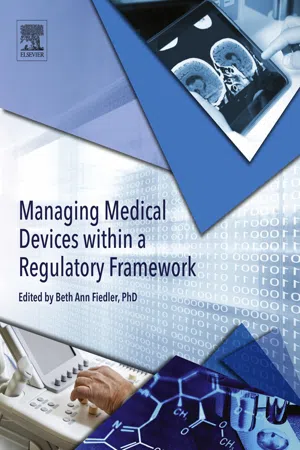1.1. Introduction
Product management through its life cycle is critical to end users and the companies that produce and market them. Major considerations include (1) production of operationally safe and effective devices; (2) financially positive return on investment made throughout the product development and manufacturing; (3) clinical improvement in care; and (4) the overarching element of “do no harm.” “The regulation of medical devices is as much about risks as it is about markets and companies” (Altenstetter, 2012, p. 364). While medical product legislation in the US had its beginning in 1938 under the Federal Food, Drug, and Cosmetic Act (FDA, 2012, 2014a), the significant impact on the design and manufacturing of medical products was the result of the Medical Device Amendment of 1976 (FDA, 2014a) that introduced the risk classification scheme giving the US Food and Drug Administration (FDA) the authority to require a premarket review process.
These legislative developments and others that followed both in the US and the world aimed at the establishment of a regulatory environment where processes and methods have been evolved to ensure the safety and effectiveness of medical products while promoting innovation. Therefore, understanding the FDA total product life cycle (TPLC) (FDA, 2015a) and the EU Medical Device Certification (MDD) (2009) processes for medical device development that leads to commercial distribution is important to achieving both consumer safety and product innovation. The global relevance is demonstrated by examining the US and the US medical device markets that, when combined, represent more than three-fourths share in a $300+ billion dollar industry (Kalorama Market Report, 2014; Eucomed, n.d.; Fierce Medical Devices Newsletter, 2012) that is growing at a rate of 4.4% a year (Eucomed, n.d.).
The introduction of the regulatory process distinguishes the medical device PLC from other industry concepts, such as the well-known product life cycle: introduction, growth, maturity, and decline. For example, the human factors element has gained a strong presence in medical device development as well as in the hospital environment of care (Duffy, 2011; Fennigkoh, 2005). Consequently, human factors engineering has driven changes in regulation guiding the medical PLC. The Agency for Healthcare Research and Quality recognizes the patient safety value of human factors engineering and the inherent risks, as interactions between and among healthcare workers, equipment, and environmental conditions depend on the application of various technologies to patients in order to save lives (Agency for Healthcare Research and Quality, 2015).
“Human factors engineering is the discipline that attempts to identify and address these issues”… by taking “into account human strengths and limitations in the design of interactive systems that involve people, tools, technology, and work environments to ensure safety, effectiveness, and ease of use” (Agency for Healthcare Research and Quality, 2015).
Two overarching directives in the FDA PLC process provide the foundation for the agency mandate to consistently determine that medical devices marketed in the US meet applicable safety and effectiveness requirements. They are found in 21 CFR 860.7(d)(1) and 21 CFR 860.7(e)(1). The clauses are noteworthy because every subsequent requirement in the Quality System Regulation, Current Good Manufacturing Practices (cGMP), and Recognized Standards stem from these points.
There is reasonable assurance that a device is safe when it can be determined, based upon valid scientific evidence, that the probable benefits to health from use of the device for its intended uses and conditions of use, when accompanied by adequate directions and warnings against unsafe use, outweigh any probable risks. The valid scientific evidence used to determine the safety of a device shall adequately demonstrate the absence of unreasonable risk of illness or injury associated with the use of the device for its intended uses and conditions of use.
21 CFR 860.7(d)(1), Reasonable assurance of safety
There is reasonable assurance that a device is effective when it can be determined, based upon valid scientific evidence, that in a significant portion of the target population, the use of the device for its intended uses and conditions of use, when accompanied by adequate directions for use and warnings against unsafe use, will provide clinically significant results.
21 CFR 860.7(e)(1), Reasonable assurance of effectiveness
Utilization of the product life cycle approach is one method to ensure product integrity. “For manufacturing processes to be fully validated”…there must be an “integration of development work, process conformance, and continuing verification” at each stage that “provides assurance that the product or process will consistently remain in control throughout the entire product lifecycle” (Pluta, 2011).
In this chapter, we provide an overview of the FDA TPLC, the EU PLC, and introduce important stages of the product life cycle for medical devices.
